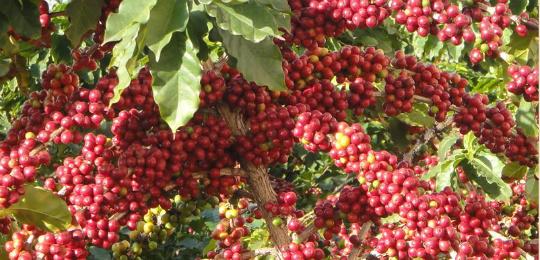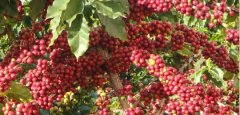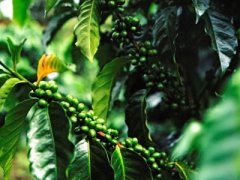Introduction to the planting flavor and taste of Tanzania coffee grade source in East Africa

Tanzania is an East African country located south of the equator, bordering Uganda and Kenya in the north and Republic of Congo, Rwanda and Burundi in the west. It is hot and humid all year round, with an average temperature of 21-25℃ in most areas. Rainfall is divided into long and short rainy seasons, with abundant annual precipitation. The economy is dominated by agriculture. Coffee is one of Tanzania's main cash crops. Arabica coffee and Robusta coffee are cultivated in Tanzania.
Mount Kilimanjaro, located in northeastern Tanzania, is the highest peak in Africa at an altitude of 5895 meters. The high altitude makes the top snow all year round, while Tanzania's main coffee producing area is located at the foot of Mount Kilimanjaro. This area has rich volcanic soil, which provides sufficient nutrients for the growth of coffee trees. Coffee trees are generally grown at altitudes above 1150 meters, which is one of the prerequisites for Arabica's superior flavor.
Tanzanian coffee is often washed, and coffee farmers will send the coffee fruit to the nearest processing plant for processing after picking. The treatment steps of the washing treatment method are as follows: firstly, impurities doped in coffee fruits are screened and removed; then coffee pulp and exocarp are removed; the coffee fruit is sent into a fermentation tank, and pectin layers adhered to the endocarp are removed through fermentation; and drying treatment is carried out after cleaning. Tanzanian coffee is graded in the same way as Kenyan coffee, according to bean size. During screening, green coffee beans are allowed to pass through a sieve with holes of fixed size. The larger the number of sieve, the larger the particles of green coffee beans. The flat beans classified by size mainly include AA+, AA and AB. In addition, there is also a set of sieve size standards for PB (peaBerry), which produces more round beans in Kenya and Tanzania, to classify the size of round beans.
Tanzania is also often compared to its neighbour kenya. It is said that Tanzania's earliest Arabica coffee was introduced from Kenya by Christians and is similar to Kenya in flavor characteristics. Grapefruit aromas and soft, bright acidity. However, since Tanzania's economic conditions are worse than Kenya's, production conditions are poorer. Tanzania is also not strict enough about quality control, destroying the quality of coffee in many processing steps, and Kenya, which is known for its high quality, cannot compete. Although it is close to Kenya's flavor, Tanzania's overall taste is smoother and softer, belonging to the balanced type. Moderately low acidity and sweetness, dark chocolate finish, moderate body. Compared with Kenya, which has outstanding personality, Tanzania is not so rich in hierarchy. After drinking, it will not give feedback on its outstanding characteristics, which makes people not too impressed with it. But on the contrary, its soft and round characteristics are also more pleasing, easy for people who have just come into contact with coffee to accept.
Important Notice :
前街咖啡 FrontStreet Coffee has moved to new addredd:
FrontStreet Coffee Address: 315,Donghua East Road,GuangZhou
Tel:020 38364473
- Prev

Introduction to the planting flavor and taste of Tanzania coffee grade source in East Africa
Tanzania is an East African country south of the equator, bordered by Uganda and Kenya to the north and the Republic of the Congo, Rwanda and Burundi to the west. It is hot and humid all the year round, with an average temperature of 21-25 ℃ in most areas. Precipitation is divided into long and short rainy seasons, and the annual precipitation is abundant. The economy is based on agriculture, coffee is one of the main cash crops in Tanzania, in Tanzania, Arabica coffee
- Next

Introduction to the description of Brazilian Hilado Coffee Flavor and taste
In the past 150 years, Brazil has been the country with the highest coffee bean production in the world, with a total annual output of about 2.7 million metric tons, accounting for 1/3 of the world's total coffee bean production. Top production area ─ Brazil Hirado in Brazil has a coffee bean planting area of 27000 square kilometers, the most famous producing area is Parana in the south of Brazil.
Related
- Detailed explanation of Jadeite planting Land in Panamanian Jadeite Manor introduction to the grading system of Jadeite competitive bidding, Red bid, Green bid and Rose Summer
- Story of Coffee planting in Brenka region of Costa Rica Stonehenge Manor anaerobic heavy honey treatment of flavor mouth
- What's on the barrel of Blue Mountain Coffee beans?
- Can American coffee also pull flowers? How to use hot American style to pull out a good-looking pattern?
- Can you make a cold extract with coffee beans? What is the right proportion for cold-extracted coffee formula?
- Indonesian PWN Gold Mandrine Coffee Origin Features Flavor How to Chong? Mandolin coffee is American.
- A brief introduction to the flavor characteristics of Brazilian yellow bourbon coffee beans
- What is the effect of different water quality on the flavor of cold-extracted coffee? What kind of water is best for brewing coffee?
- Why do you think of Rose Summer whenever you mention Panamanian coffee?
- Introduction to the characteristics of authentic blue mountain coffee bean producing areas? What is the CIB Coffee Authority in Jamaica?

